© ROOT-NATION.com - Use of content is permitted with a backlink.
Recently, the naval forces of the Armed Forces of Ukraine struck another Russian ship – the Vasily Bekh rescue tug of the Russian Black Sea Fleet. This time with Harpoon anti-ship missiles. Today we are going to talk about these missiles.
After Russia’s attack on Ukraine in February, our defenders received a lot of modern military equipment from their Western partners, from armored vehicles and tanks to missile systems and ammunition. Among them are the Harpoon anti-ship missiles provided by Denmark.
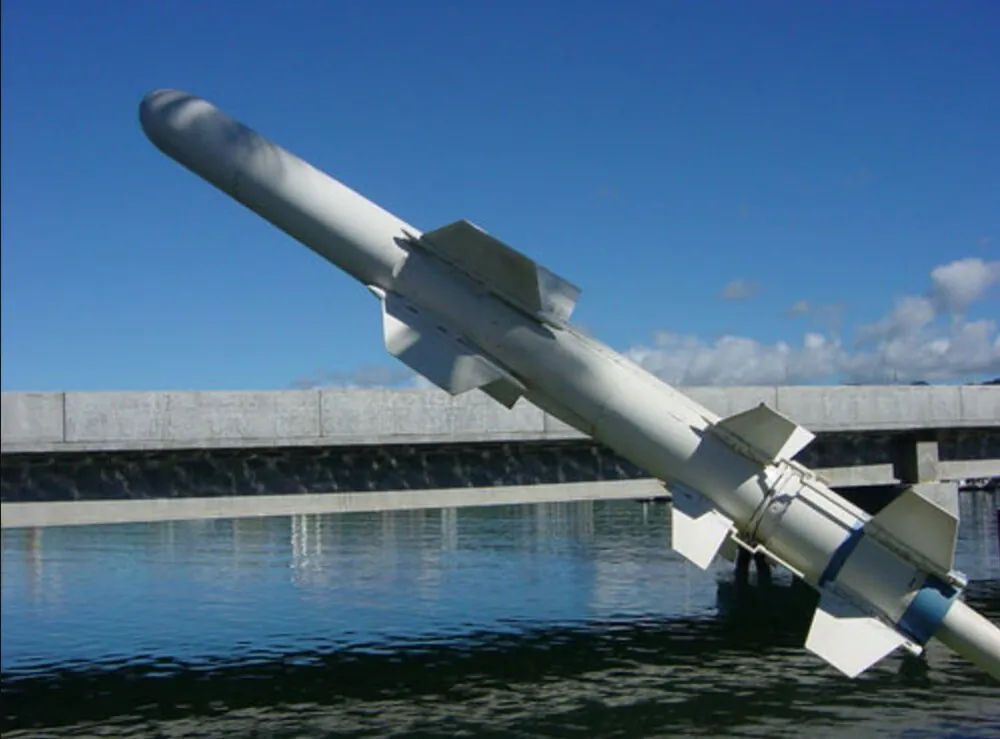
Ukraine needs modern anti-ship weapons to be able to withstand the Russian Navy and its Black Sea Fleet. Russian ships fire cruise missiles at our territory from hundreds of kilometers away from the Ukrainian coast and block Ukrainian ports, disrupting grain exports, creating a global food crisis. The efficiency of the enemy fleet is supported by the Black Sea Fleet base Sevastopol – the main port of the Crimean peninsula, occupied in 2014. But no Russian ship can feel safe after the flagship of the Black Sea Fleet, the Moskva cruiser, was sunk by Ukranian-made Neptune missiles. In addition to that, we have high hopes for Harpoon anti-ship missiles that can change the course of the confrontation at sea.
Read also: All about the 155mm M777 howitzer and M982 Excalibur guided projectile
Why are Harpoon missiles interesting?
While the Javelins are the most famous anti-tank weapons, the Polish Peruns are the most popular anti-aircraft systems, and the Bayraktar TB2 are the kings of drones (at least in the war in Ukraine), the Harpoon is one of the world’s most famous and powerful anti-ship missiles. And the fact that they are used by more than 600 surface ships, 180 submarines, 12 types of jets and a number of ground-based coastal defense systems, only confirms this.

The Harpoon is a subsonic anti-ship cruise missile developed in the United States that has been in the Pentagon’s service since 1977. Since its inception, many modifications have been released, including air, ship and submarine versions. Harpoon has also undergone many upgrades, which has improved missile range and aiming accuracy. Various types of this powerful anti-ship missile have been exported to 32 countries.
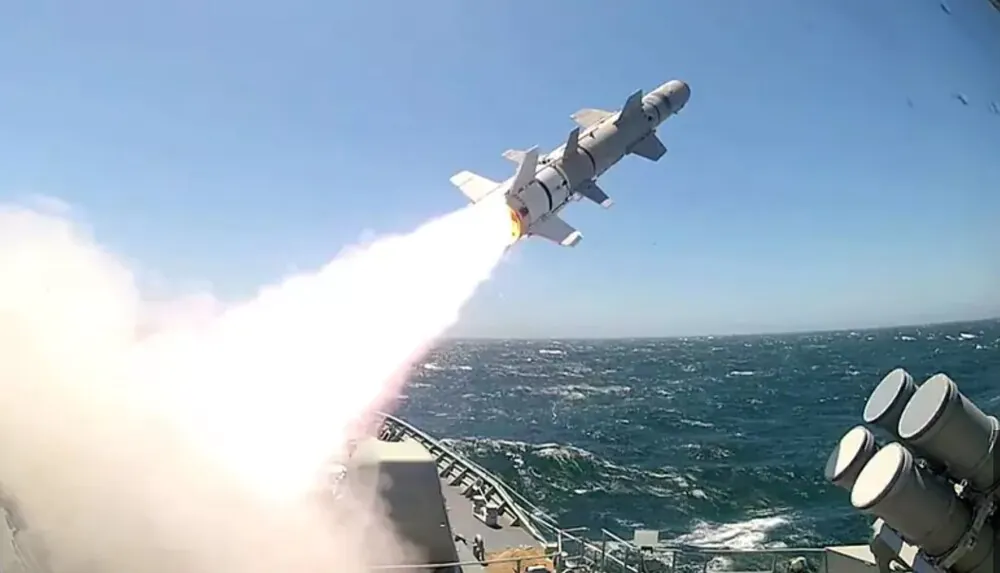
Read also: Weapons of Ukrainian Victory: the French Caesar self-propelled howitzer
History of Harpoon development
In 1965, the United States Navy began work on a missile to hit submarines with a range of up to 45 km. Because the missile was to be aimed at ‘whales’, as submarines are called in slang, the project was named Harpoon. The Egyptian sinking of the Israeli destroyer Eilat in 1967 by two Soviet-made anti-ship missiles shocked senior US Navy officers who had not yet fully realized the threat posed by anti-ship missiles. So in 1970, Admiral Elmo Zumwalt, chief of naval operations, accelerated the development of Harpoon as part of his Project Sixty initiative, which was to significantly increase the strike power of US surface warships, such as the Ticonderoga missile cruisers.
Today the Harpoon anti-ship missile is probably the most common weapon of this type in the West. Since its inception in 1975, McDonnell Douglas (now part of Boeing) has manufactured more than 7,000 missiles, equipping hundreds of ships around the world, at a fairly reasonable price of about $ 1.5 million. In addition, this weapon system is universal, it can be launched from aircraft, surface and submarines.

Since 1977, the US Navy has adopted the Harpoon as its primary anti-ship missile. Shortly afterwards, in 1979, an aviation version of the missile appeared, which was first installed on a naval patrol aircraft P-3 Orion Navy, and later on other aircraft, such as F / A-18 Hornet and B-52H Bomber.
The air version of the Block 1 E missile (AGM-84E), known as the Standoff Land Attack Missile (SLAM), allowed targeting ground targets. SLAM with advanced capabilities (SLAM-ER) appeared in 1997, doubling the range of the missile, as well as introducing automatic targeting technology (ATA). Harpoon Block II, the most advanced version of the missile, equipped with a new on-board computer and GPS/INS navigation system, was introduced in 2009, it has an autonomous range over the horizon and can attack both naval and ground targets. Version Block II + is currently under development.
Read also: Weapons of Ukrainian Victory: Modern PzH 2000 self-propelled howitzers
Harpoon anti-ship missile modifications
Let’s take a closer look at the upgraded versions of the Harpoon. Since its introduction in 1977, Harpoon has received many hardware and software upgrades, leading to many modifications of the missile. For clarity, in 1973 the Navy defined the following designations for the Harpoon family: A – air launch, R – surface from ships, U – underwater launch, G – surface strike, M – guided missile.

Harpoon received several different versions known as Blocks. Of course, the original model is known as Harpoon Block I, and then there were further variations.
Block IA (RGM/UGM/AGM-84A)
Because the AGM-84A does not have solid propellant accelerators, it can only attack targets in dive mode. This version of the missile is shorter and lighter than those designed for surface and underwater launch. AGM-84A has a length of 3.85 m, a diameter of 0.343 m, a starting weight of 556 kg, while the RGM/UGM-84A has a length of 4.64 m, a diameter of 0.343 m and a starting weight of 682 kg.
The AGM-84A has a longer range of 120 km compared to the RGM / UGM-84A, which flies only 92.6 km. Inertial mid-course navigation and active radar are used to guide the Block IA model during the final flight phase. The missiles are equipped with a high-explosive warhead weighing 224 kg. There are two versions of special launchers for Harpoon – Mark 140 Mod-0 and Mark 141 Mod-1, which can launch one rocket every two seconds. The UGM-84A Encapsulated Harpoon Weapon System (EHWS) is essentially the same as the RGM-84A, except that it is launched from a submarine’s torpedo launchers in a launch capsule.
Block IB (RGM/UGM-84C)
Introduced in 1982, this version contains only minor changes to the flight profile and software compared to Block IA. The flight path has a lower altitude, instead of performing a pop-up maneuver, Block IB attacks the target at ultra-low altitude. In addition, this option has advanced electronic countermeasures (ECCM) to improve the guidance accuracy.
Block IC (RGM/UGM-84D)
Introduced in 1985, Block IC differs from previous versions in flight path, guidance system and targeting technology.
While Block IB and IA can perform either a low-rise pop-up or a low-altitude approach, Block IC can do both. In addition to the improved ECCM characteristics, the Block IC has a slightly higher altitude in the first stage of the flight trajectory to avoid damaging its ships and other obstacles that may be in the path of the missile. Changing the type of fuel used in the rocket increased its range to 124 km.

Block ID (RGM84-F)
Introduced in 1991, the 5.3 m long Block ID missile showed increased range – up to 240 km. The guidance system was changed, which allowed to re-attack the target in case of a miss. However, this model was discontinued in 2003 because its length and weight limited the types of launchers capable of launching this missile (both surface and underwater).
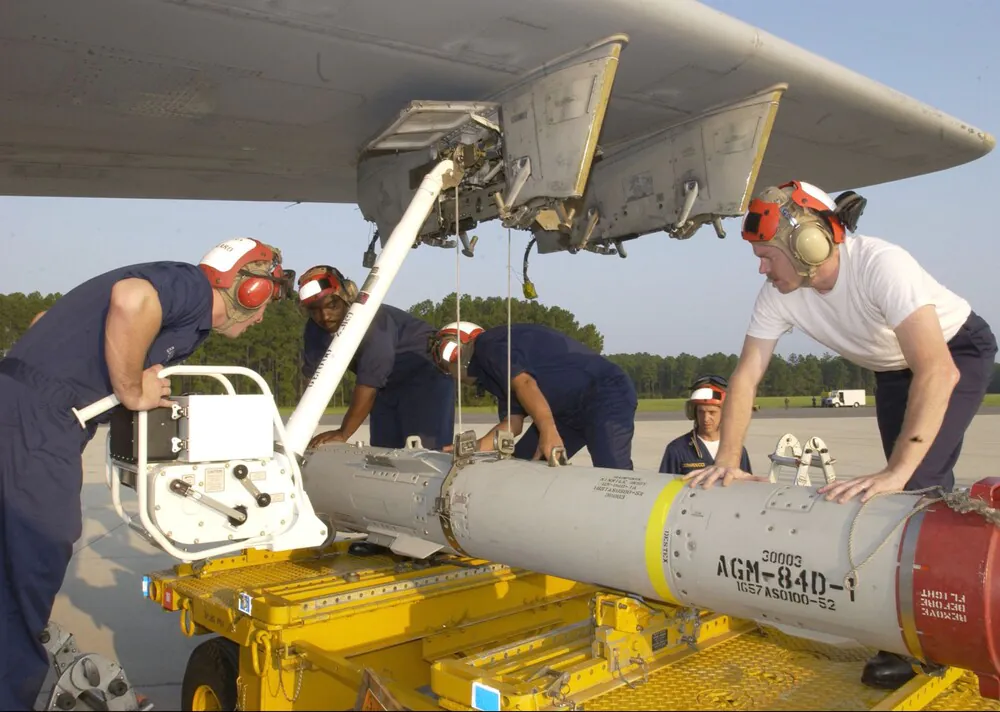
Block IE (AGM-84E/SLAM)
The SLAM (Standoff Land Attack Missile) variant is an air-to-surface missile. It uses Harpoon’s glider, warhead and engine, but it is otherwise very different from its predecessors. The addition of a GPS receiver, a Walleye infrared guidance system (IIR) and a Maverick data link system has significantly increased the target hitting accuracy. The missile has a length of 4.5 m, a diameter of 0.34 m, and a launch weight of 628 kg. SLAM entered service in 1990 and was successfully involved in Operation Desert Storm and the UN Mission in Bosnia.
Block IG (RGM/UGM-84G)
The Block IG variant was developed for ships equipped with light launchers that could not use the longer RGM-84F. In other words, Block IG has all the updates that were in the Block ID model, except for the extended fuel tank, so the maximum range of this rocket is similar to Block IC. Launched in 1999, this system uses advanced software that allows it to pass up to eight route points during the flight, and is equipped with automatic coastline avoidance technology.
Block IH (AGM-84K/SLAM-ER)
SLAM-ER (improved version) first came into service in 1999. The system has an advanced IIR finder, a titanium warhead for greater penetration and arrow-shaped wings that deploy in flight (similar to the RGM/UGM 109 Tomahawk design) to increase the maximum range of the missile to 280 km. The missile uses inertial navigation and GPS for mid-range guidance before switching to IIR in its final flight phase. It should be noted that SLAM-ER uses two-way data link communication with the Advanced Data Link AWW-13 module, which allows the operator to see the target in real time. SLAM-ER is also the first weapon with automatic target detection technology, which allows the missile to overcome infrared countermeasures more effectively, better distinguish targets in a busy battle scene and limit the impact of adverse weather conditions on missile accuracy. The missile is capable of hitting moving ships and moving ground targets with a relative maximum error of up to 3 m.
Block II (RGM/UGM-84J/L)
First delivered by the US Navy in 2009, the Block II variant combines an inertial measuring unit and software from the Joint Direct Attack Munition with an inertial GPS / INS navigation system from SLAM-ER. These improvements in missile guidance technology allow it to operate in coastal waters and attack both naval and ground targets. In addition, the guidance system is able to aim beyond the horizon with the help of a helicopter, which allows aiming at hidden targets outside the line of sight of radar. The missile carries a warhead weighing 224 kg and has a maximum spread of 10-13 m.
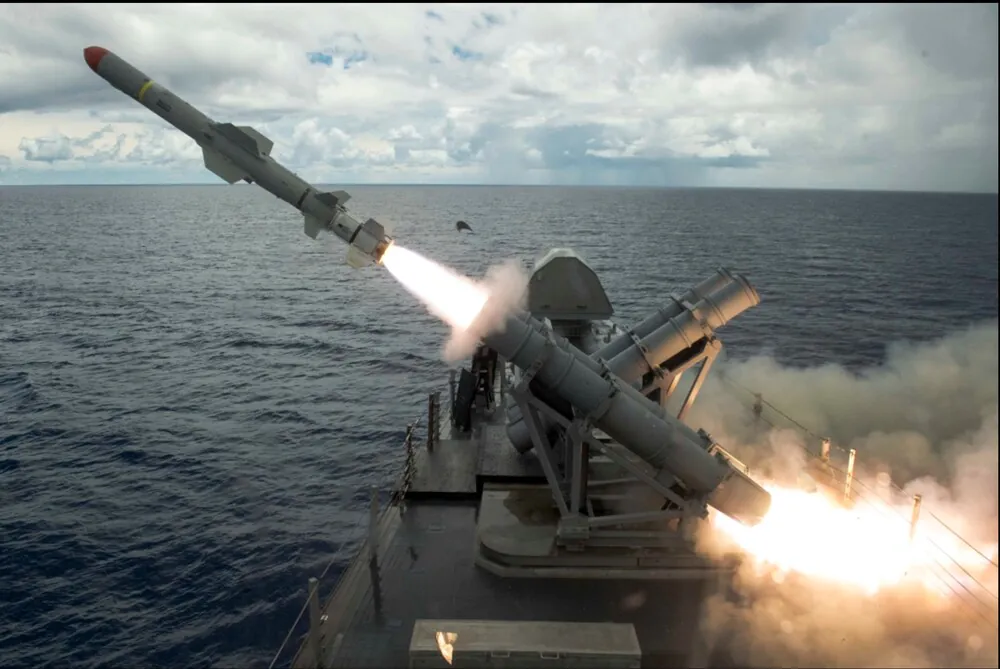
It is this modification that is now in the service of our military, and this is exactly the missile that recently hit the tug of the occupiers.
Read also: Silent killers of modern warfare: most dangerous military UAVs
Block II+ ER
Introduced in 2015 by Boeing as the next generation of Harpoon, the Block II+ Extended Range aims to increase the uncategorized range of the Block II by 124 km. To do this, the missile uses a lighter but more efficient warhead, as well as an improved turbojet engine, which doubles the range of the missile to 248 km. Block II+ is limited to F/A-18 and P-8 Increment III naval patrol aircraft. That is, this option is experimental rather than working.
Read also: Modern artillery is Ukraine’s superweapon. And what does Elon Musk have to do here?
Harpoon’s success in combat
Harpoon has been used many times in combat during almost half a century of service. As part of Operation Morvarid, the Iranian Navy used Harpoon missiles against Iraqi ships. In November 1980, the Iranian rocket ship Paikan launched a total of three Harpoon missiles on three Iraqi OSA II high-speed strike ships. The Harpoons neutralized the targets and allowed Iran to continue the operation.
In March 1986, the US Navy used Harpoon missiles against Libyan troops in the Gulf of Cider. After US Navy aircraft were attacked by 4-6 surface-to-air missiles, the USS Yorktown (DDG-48) fired two Harpoon anti-ship missiles and several other missiles from an A-6 attack aircraft on two Libyan patrol boats. One of the ships caught fire and sank, and the other was severely damaged.

On April 18, 1988, the United States sank several Iranian ships with the help of Harpoon during Operation Praying Mantis in the Persian Gulf. After four separate warning volleys to the Iranian missile boat Joshan, which was approaching US warships, the USS Wainwright (CG-28) sank the ship with harpoons. Iranian Joshan launched his own Harpoon missile on the American ship Wainwright, but it was fended off by electronic countermeasures by Wainwright. In response, the Americans launched six standard missiles (SM-1) and one Harpoon missile. The Iranian ship was severely damaged in the attack and was completely sunk by Wainwright (CG-28) artillery from close range. It was a real duel on the Harpoons.
Another ship, the Iranian frigate Sahand (F 74), launched missiles from its deck on an American aircraft. The plane dodged the missiles and fired two Harpoon missiles in response, which accurately found their target. The American frigate USS Strauss (DDG-16) also hit the already damaged Sahand with a Harpoon missile, sinking it completely.
Read also: All about the General Atomics MQ-9 Reaper
Unsuccessful Harpoon launches
There were also two accidental launches of the Harpoon system. On July 14, 1981, the USS Coontz (DDG-40) accidentally launched a missile that traveled nearly 110 km before it probably self-destructed at sea.
A year later, on September 6, 1982, the Danish frigate HDMS Peder Skram (F352) accidentally fired a Harpoon missile during maneuvers, causing significant damage to power lines and the property of more than 130 cottages, but no one was killed.
Read also: TOP-10 ‘unmatched’ Russian armaments destroyed by the Armed Forces of Ukraine
Specifications of Harpoon missiles
- Weight: 540-691 kg
- Length: 3,8-4,6 m
- Diameter: 34,3 cm
- Engine: turbojet engine and solid fuel accelerator
- Wingspan: 91,4 cm
- Effective range: 140-280 km
- Maximum altitude: 915 m
- Speed: 850 km/h (Mach 0,85)
- Targeting system: inertial guidance with radio altitude meter and active radar at the end of the flight
- Warhead: 221 kg, high explosive
- Unit cost: $1 527 416
Read also: Weapons of Ukrainian victory: FIM-92 Stinger MPADS
Why does Ukraine need Harpoon missiles?
Ukrainian Neptune missiles can hit targets at a distance of up to 280 km, and Harpoons – up to 310 km in the latest versions, but we must not forget about the most important thing…
The theoretical advantage of Harpoon missiles over Neptune, however, is questionable in practice. This is due to the fact that in the best modification (Harpoon Block II+ ER) Harpoon can hit targets at a distance of up to 310 km, but Denmark does not have access to them, so, of course, could not provide them to Ukraine. On the other hand, we still do not know how the practical range is compared with the theoretical in the case of Ukrainian Neptunes. But they proved their potential by destroying the Russian flagship cruiser Moskva. It is a pity that we are simply short on our Neptunes.
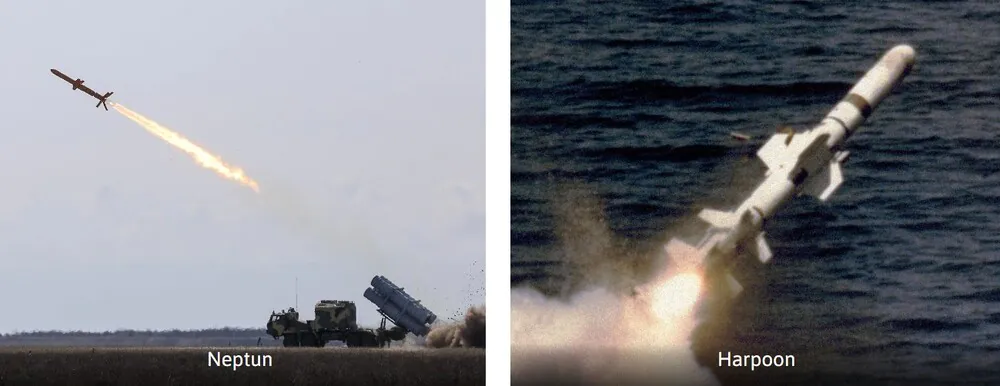
It is known that the actual range of most developed versions of Harpoon (including those to which Denmark has access) is less, so it is around 120 km. What about Neptune, developed on the basis of Soviet missiles? Nobody knows, because we just lack data on this, and this applies to their general capabilities. But the Harpoon Block II (RGM/UGM-84J/L), in turn, has been tested in combat, and their effectiveness and capabilities are supported by strong evidence.
Therefore, we can hope that in the current situation, Ukraine, having received Harpoon missiles with ground launchers, will be able to destroy the Russian fleet with greater accuracy and at greater range. This will push Russian ships farther from shore, which will prevent them from achieving their goals. The sinking of the Vasiliy Bekh tug has already proved Harpoon’s effective work, and we expect great news from them in the future.
Read also:
- ‘Neptunes’ knocked out ‘Moskva’ cruiser: All about these anti-ship cruise missiles
- Weapons of Ukrainian victory: ATGM Stugna-P – Russian tanks are in trouble
We believe that Ukraine will definitely win. We believe in the Armed Forces! The orcs should burn in hell, and Harpoons and Neptunes will definitely help them in this!
You can also help Ukraine fight with Russian occupants via Savelife or via an official page of the National Bank of Ukraine.

